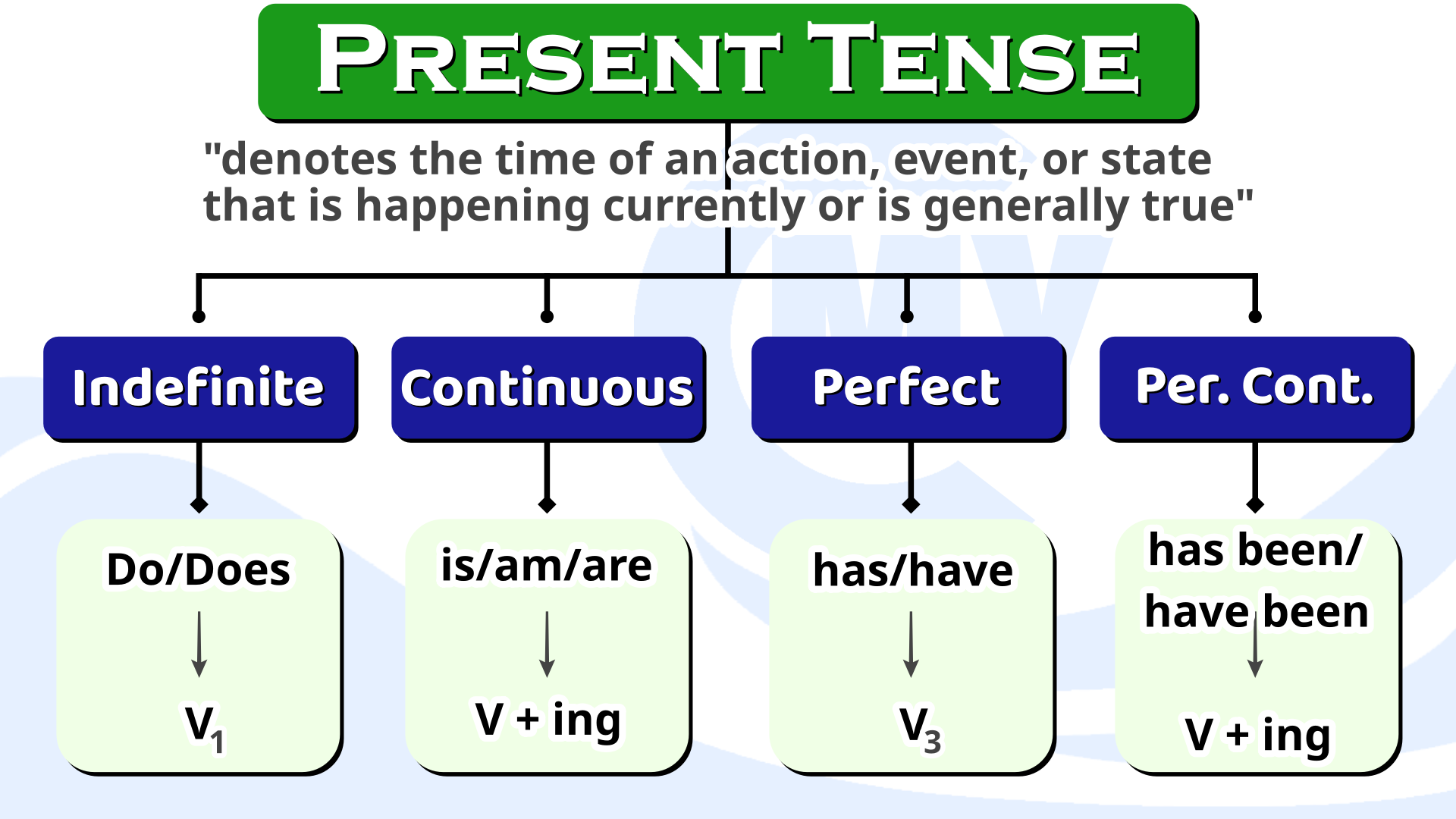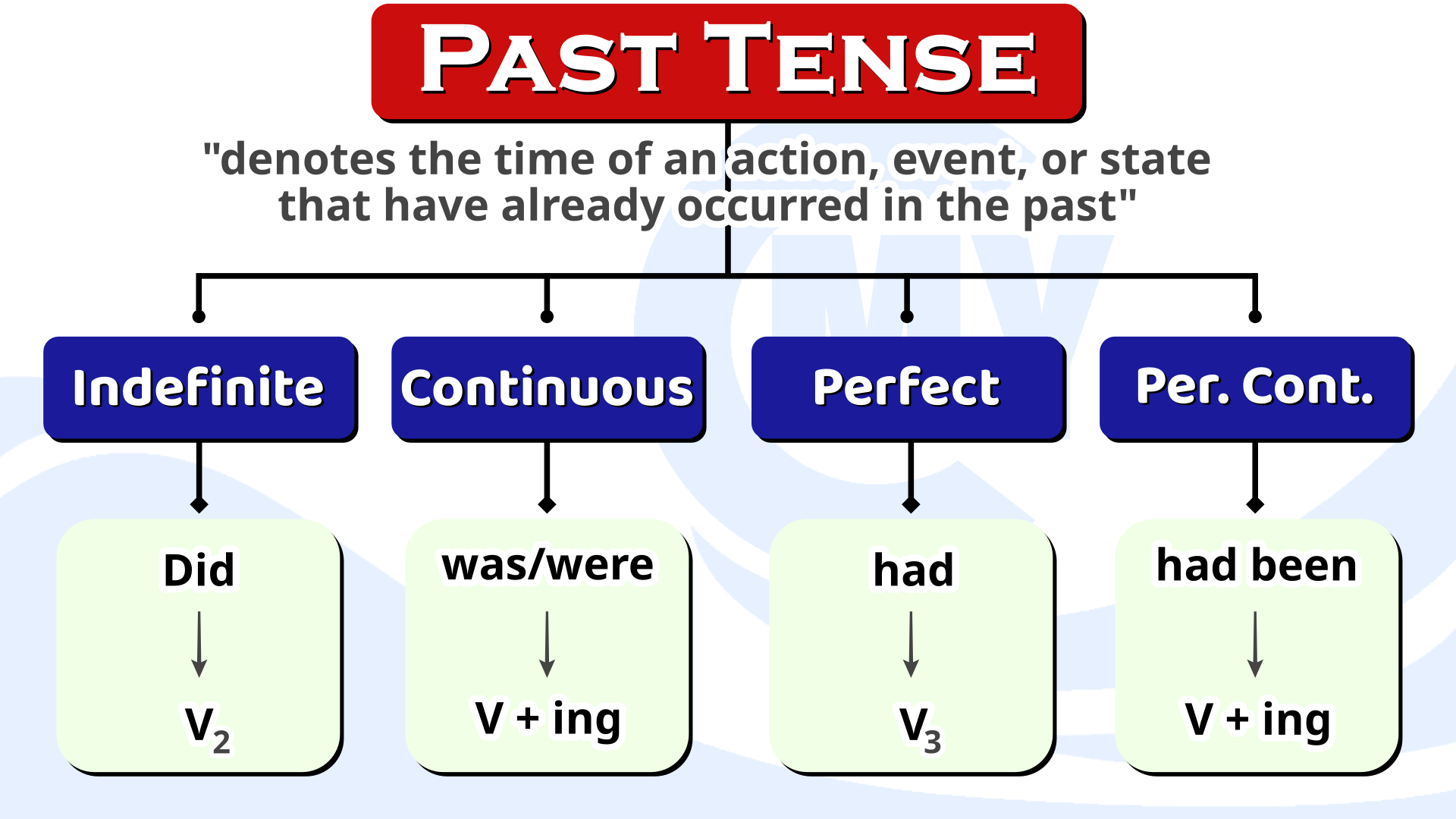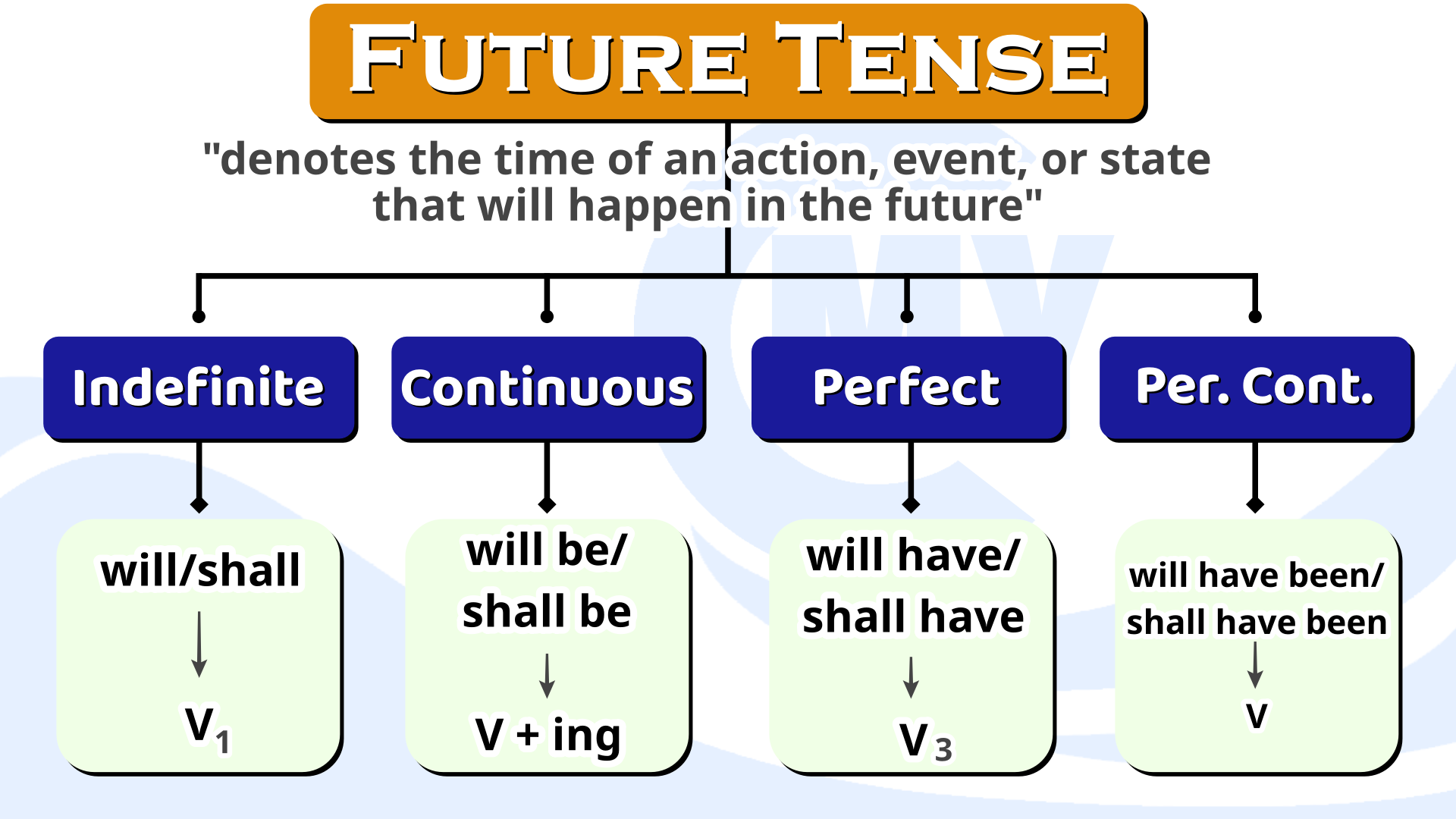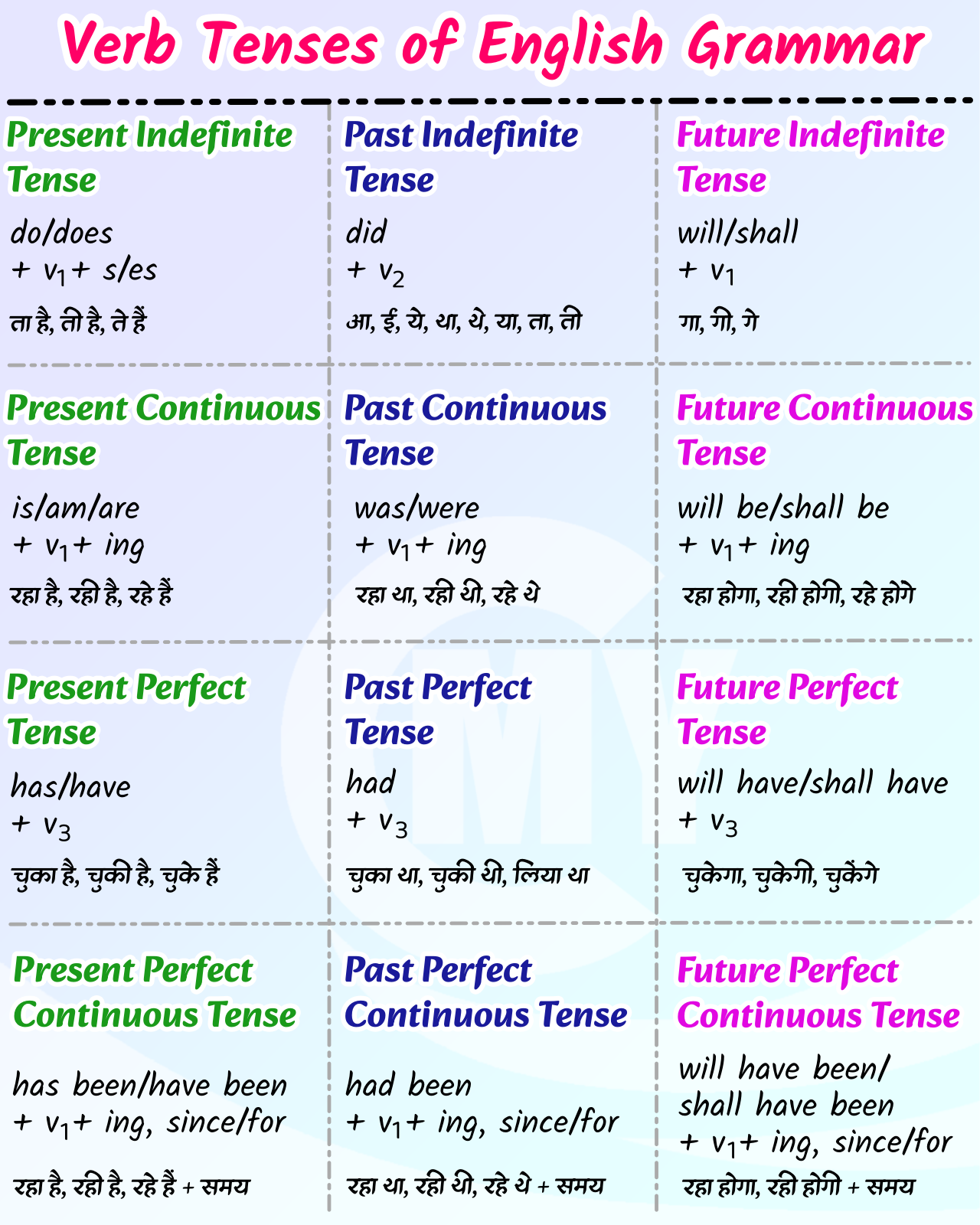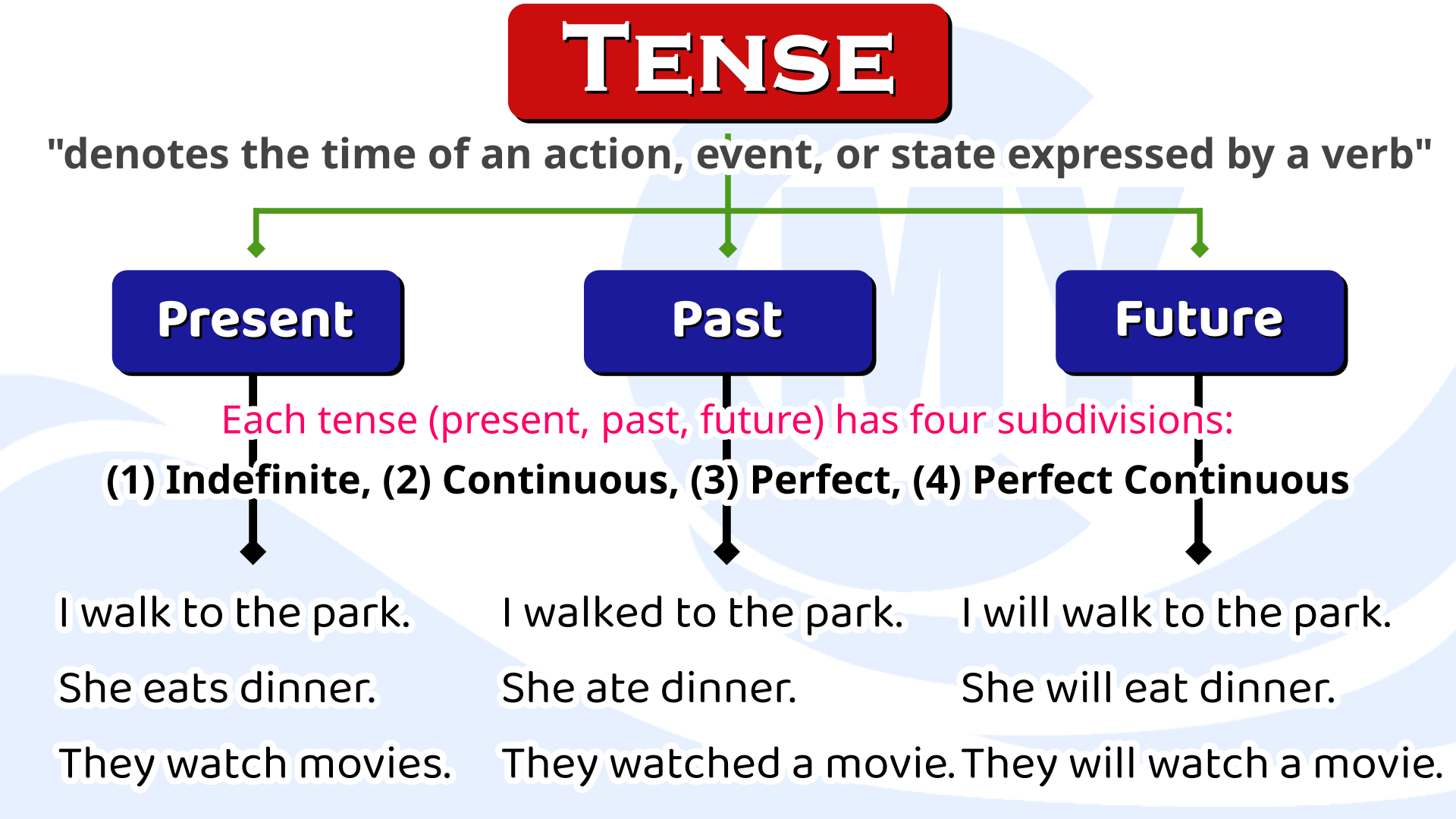
In grammar, tense refers to the form of a verb that indicates the time at which an action, event, or state of being takes place. It helps to establish the temporal relationship between different elements in a sentence. (व्याकरण में, काल क्रिया के उस रूप को दर्शाता है जो उस समय को इंगित करता है जब कोई कार्य, घटना या अवस्था घटित होती है। यह एक वाक्य में विभिन्न तत्वों के बीच लौकिक संबंध स्थापित करने में मदद करता है।)
Tense can be used to express actions or states that occurred in the past, are occurring in the present, or will occur in the future. (Tense का उपयोग उन क्रियाओं या अवस्थाओं को व्यक्त करने के लिए किया जा सकता है जो भूतकाल में घटित हुई थीं, वर्तमान में घटित हो रही हैं, या भविष्य में घटित होंगी।)
अतः कह सकते हैं-
Tense is a grammatical category that denotes the time of an action, event, or state expressed by a verb, specifically focusing on whether it is completed or ongoing with respect to the present, past, or future. (काल एक व्याकरण का भाग है जो एक क्रिया द्वारा व्यक्त की गई कार्य, घटना या स्थिति के समय को दर्शाती है, विशेष रूप से इस बात पर ध्यान केंद्रित करती है कि क्या यह वर्तमान, भूत या भविष्य के संबंध में पूर्ण या जारी है।)
Types of Tense:
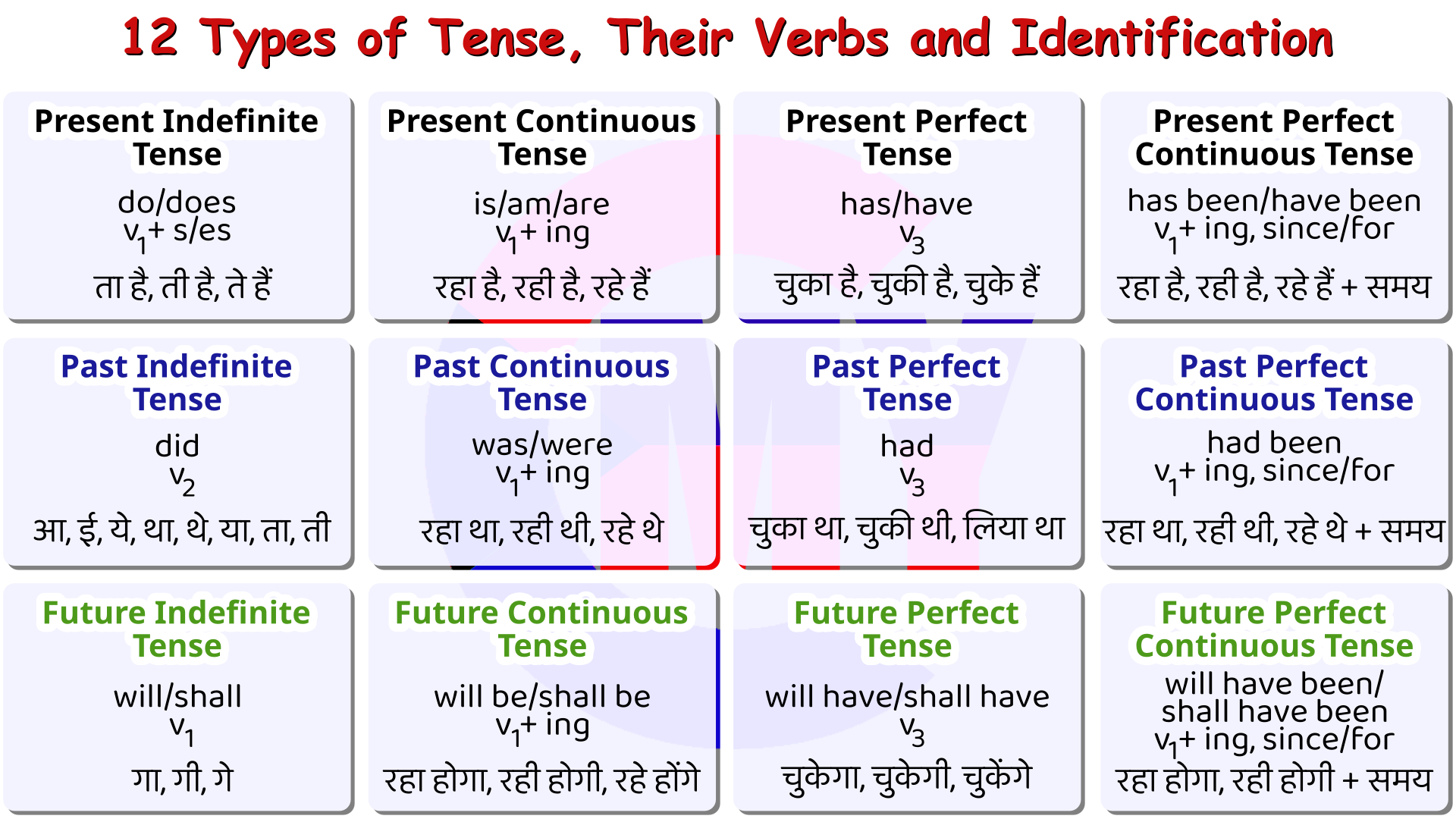
English commonly has three primary tenses: present, past, and future. Each tense has various forms to indicate different aspects, such as simple, continuous, perfect, and perfect continuous. Brief overview of the three primary tenses of English Grammar are given below:
- Present Tense (वर्तमान काल)
- Past Tense (भूतकाल)
- Future Tense (भविष्य काल)
आइए अब विस्तार से जानते हैं तीनों के बारे में-
Present Tense
This tense is used to describe actions, events, or states that are happening currently or are generally true. (इसका उपयोग उन क्रियाओं, घटनाओं या अवस्थाओं का वर्णन करने के लिए किया जाता है जो वर्तमान में हो रही हैं या प्रायः सत्य होती हैं।) For example:
- I walk to the park. (मैं पार्क में टहलता हूं।)
- She eats dinner. (वह रात का खाना खाती है।)
- They watch movies. (वे फिल्में देखते हैं।)
There are four main types of present tense:
- Present Indefinite Tense (Simple Present Tense)
- Present Continuous Tense
- Present Perfect Tense
- Present Perfect Continuous Tense
1. Present Indefinite Tense/Simple Present Tense:
The present indefinite tense is used to describe actions, states, or situations that are generally true, habitual, or permanent. It is formed by using the base form of the verb. For example:
- She sings beautifully.
- They study at the library.
- The sun rises in the east.
Rules:
- Affirmative Sentences: Subject + Verb1 (s/es) + Object + Rest.
- Negative Sentences: Subject + do/does + not + Verb1 + Object + Rest.
- Interrogative Sentences: Do / Does + Subject + Verb1 + Object + Rest?
| Affirmative | Negative | Interrogative |
|---|---|---|
| I eat breakfast every morning. | I do not like spicy food. | Do you like ice cream? |
| She plays tennis on weekends. | She does not speak French. | Does she play the piano? |
| We watch movies together on Fridays. | We do not have a car. | Do we have any plans for tonight? |
| They study English in the evening. | They do not play video games. | Do they live in this neighborhood? |
| He works at a bank. | He does not enjoy swimming. | Does he know the answer? |
| The cat chases mice. | The dog does not bark at strangers. | Does the bus arrive on time? |
| We go for a walk in the park. | We do not go to the gym. | Do we need to bring anything? |
| The sun rises in the east. | The moon does not emit its own light. | Does it rain a lot in this city? |
Note: In the present indefinite tense, the third person singular pronouns (he, she, it) take the auxiliary verb “does” in the negative and interrogative sentences, while other pronouns and nouns use “do.”
2. Present Continuous Tense:
The present continuous tense is used to describe actions that are happening at the moment of speaking or around the current time. It is formed by using the present tense of the verb “to be” (am, is, are) + the present participle (-ing form) of the main verb. For example:
- I am writing a letter.
- He is reading a book.
- They are playing soccer.
Rules:
- Affirmative Sentences: Subject + is/am/are + Verb1 + ing + Object + Rest.
- Negative Sentences: Subject + is /am/are + not + Verb1 + ing + Object + Rest.
- Interrogative Sentences: is /am/are + Subject + Verb1 + ing + Object + Rest?
| Affirmative | Negative | Interrogative |
|---|---|---|
| I am reading a book right now. | I am not watching television at the moment. | Are you having a good time? |
| She is dancing at the party. | She is not working on weekends. | Is she coming to the party? |
| We are studying for our exams. | We are not going to the movies tonight. | Are we going to the beach tomorrow? |
| They are playing football in the park. | They are not wearing their jackets. | Are they playing basketball this evening? |
| He is cooking dinner for us. | He is not listening to music right now. | Is he sleeping? |
Note: In the present continuous tense, the auxiliary verb “am,” “is,” or “are” is used with the base form of the verb, and the present participle (-ing form) is added to indicate an action that is happening at the present moment or around the current time. In negative sentences, “not” is placed between the auxiliary verb and the main verb. In interrogative sentences, the auxiliary verb is placed at the beginning of the sentence, followed by the subject and the main verb.
3. Present Perfect Tense:
The present perfect tense is used to describe actions or events that happened in the past but have a connection to the present. It is formed by using the present tense of the verb “to have” (have, has) + the past participle of the main verb. For example:
- She has visited Paris twice.
- We have finished our homework.
- They have seen that movie before.
Rules:
- Affirmative Sentences: Subject + Has/have + Verb3 + Object + Rest.
- Negative Sentences: Subject + Has/Have + not + Verb3 + Object + Rest.
- Interrogative Sentences: Has/Have + Subject + Verb3 + Object+ Rest?
| Affirmative | Negative | Interrogative |
|---|---|---|
| I have completed my assignment. | I haven’t seen him today. | Have you ever been to Japan? |
| They have visited Paris several times. | They haven’t finished their homework yet. | Have they finished their project? |
| She has finished reading the book. | She hasn’t traveled abroad before. | Has she seen the latest movie? |
| We have lived in this city for ten years. | We haven’t received the package. | Have we met before? |
| He has won the championship. | He hasn’t played the guitar in months. | Has he completed the task? |
Note: In the present perfect tense, the verb “have” is used as an auxiliary verb, followed by the past participle form of the main verb. The form of “have” changes depending on the subject (e.g., “have” for I, you, we, they, and “has” for he, she, it).
4. Present Perfect Continuous Tense:
The present perfect continuous tense is used to describe actions or states that started in the past, have continued up until the present, and may continue into the future. It is formed by using the present tense of the verb “to have” (have, has) + been + the present participle (-ing form) of the main verb. For example:
- He has been studying for three hours.
- We have been waiting for the bus since morning.
- They have been playing tennis all day.
Rules:
- Affirmative Sentences: Subject + has/have + been + Verb1 + ing + Object + for/Since + time.
- Negative Sentences: Subject + has/have + not + been + Verb1 + ing + Object + for/since + time.
- Interrogative Sentences: Has/have + subject + been + Verb1 + ing + Object + for/since + time?
| Affirmative | Negative | Interrogative |
|---|---|---|
| I have been studying for the exam all morning. | I haven’t been watching TV all day. | Have you been waiting here for a long time? |
| They have been playing soccer since 3 p.m. | They haven’t been practicing the piano recently. | Have they been playing basketball all afternoon? |
| She has been working on the project for weeks. | She hasn’t been attending the yoga classes lately. | Has she been working late every day? |
| We have been learning French for six months. | We haven’t been studying Spanish this semester. | Have we been discussing this issue for too long? |
| He has been jogging for an hour. | He hasn’t been exercising regularly. | Has he been practicing his guitar skills recently? |
Note: In the present perfect continuous tense, the verb “have” is used as an auxiliary verb, followed by “been,” and then the present participle form (-ing) of the main verb. The form of “have” changes depending on the subject (e.g., “have” for I, you, we, they, and “has” for he, she, it).
Past Tense
This tense is used to describe actions, events, or states that have already occurred in the past. (इसका उपयोग उन क्रियाओं, घटनाओं या अवस्थाओं का वर्णन करने के लिए किया जाता है जो पहले ही घटित हो चुकी हैं।) For example:
- I walked to the park. (मैं पार्क में टहलनें गया।)
- She ate dinner. (उसने रात का खाना खा लिया।)
- They watched a movie. (उन्होंने एक फिल्म देखी।)
There are four main types of past tense:
- Past Indefinite Tense (Simple Past Tense)
- Past Continuous Tense
- Past Perfect Tense
- Past Perfect Continuous Tense
1. Past Indefinite Tense/Simple Past Tense:
The past indefinite tense is used to describe completed actions or states in the past. It is typically formed by adding “-ed” to regular verbs or using the irregular verb form. For example:
- I walked to the park yesterday.
- She ate dinner at the restaurant.
- They played soccer last weekend.
Rules:
- Affirmative Sentences: Subject + Verb2 + Object + Rest.
- Negative Sentences: Subject + did + not + Verb1 + Object + Rest.
- Interrogative Sentences: Did + Subject + Verb1 + Object + Rest?
| Affirmative | Negative | Interrogative |
|---|---|---|
| She watched a movie last night. | She did not watch a movie last night. | Did she watch a movie last night? |
| They completed their homework on time. | They did not complete their homework on time. | Did they complete their homework on time? |
| He visited his grandparents during the summer break. | He did not visit his grandparents during the summer break. | Did he visit his grandparents during the summer break? |
| We went to the beach yesterday. | We did not go to the beach yesterday. | Did we go to the beach yesterday? |
| The dog barked loudly at the mailman. | The dog did not bark loudly at the mailman. | Did the dog bark loudly at the mailman? |
Note: In the above examples, “watched,” “completed,” “visited,” “went,” “barked,” and “did” are the past tense forms of the verbs “watch,” “complete,” “visit,” “go,” “bark,” and “do,” respectively.
2. Past Continuous Tense:
The past continuous tense is used to describe ongoing actions that were happening in the past. It is formed by using the past tense of the verb “to be” (was, were) + the present participle (-ing form) of the main verb. For example:
- I was studying when the phone rang.
- He was playing the piano all evening.
- They were talking about their vacation plans.
Rules:
- Affirmative Sentences: Subject + was/were + Verb1 + ing + Object + Rest.
- Negative Sentences: Subject + was/were + not + Verb1 + ing + Object + Rest.
- Interrogative Sentences: Was/were + Sub. + Verb + Verb1 + ing + Object + Rest?
| Affirmative | Negative | Interrogative |
|---|---|---|
| She was studying all night for the exam. | She was not studying all night for the exam. | Was she studying all night for the exam? |
| They were playing football in the park. | They were not playing football in the park. | Were they playing football in the park? |
| He was cooking dinner when the guests arrived. | He was not cooking dinner when the guests arrived. | Was he cooking dinner when the guests arrived? |
| We were watching a movie at the theater. | We were not watching a movie at the theater. | Were we watching a movie at the theater? |
| The kids were playing with their toys. | The kids were not playing with their toys. | Were the kids playing with their toys? |
Note: In the above examples, “studying,” “playing,” “cooking,” “watching,” and “playing” are the present participle forms of the verbs “study,” “play,” “cook,” “watch,” and “play,” respectively. The helping verb “was” is used with the singular subjects, and “were” is used with the plural subjects to form the past continuous tense.
3. Past Perfect Tense:
The past perfect tense is used to describe actions or states that occurred before another point in the past. It is formed by using the past tense of the verb “to have” (had) + the past participle of the main verb. For example:
- She had already finished her work when I arrived.
- We had seen that movie before it was released.
- They had visited Paris twice before their honeymoon.
Rules:
- Affirmative Sentences: Subject + had + Verb3 + Object + Rest.
- Negative Sentences: Subject + had + not + Verb3 + Object + Rest.
- Interrogative Sentences: Had + Subject + Verb3 + Object+ Rest?
| Affirmative | Negative | Interrogative |
|---|---|---|
| She had finished her work before the meeting started. | She had not finished her work before the meeting started. | Had she finished her work before the meeting started? |
| They had already left when we arrived at the party. | They had not already left when we arrived at the party. | Had they already left when we arrived at the party? |
| He had completed his assignment before the deadline. | He had not completed his assignment before the deadline. | Had he completed his assignment before the deadline? |
| We had visited that city several times before. | We had not visited that city before. | Had we visited that city before? |
| The movie had already started when we got to the theater. | The movie had not already started when we got to the theater. | Had the movie already started when we got to the theater? |
Note: In the above examples, “finished,” “left,” “completed,” “visited,” and “started” are the past participle forms of the verbs “finish,” “leave,” “complete,” “visit,” and “start,” respectively. The helping verb “had” is used to form the past perfect tense.
4. Past Perfect Continuous Tense:
The past perfect continuous tense is used to describe ongoing actions that had been happening for a duration of time before another point in the past. It is formed by using the past tense of the verb “to have” (had) + been + the present participle (-ing form) of the main verb. For example:
- By the time he left, I had been waiting for hours.
- They had been living in that house for ten years before they moved.
- She had been studying for the exam all week.
Rules:
- Affirmative Sentences: Subject + Had + been + Verb1 + ing + Object + for/Since + time.
- Negative Sentences: Subject + had + not + been + Verb1 + ing + Object + for/since + time.
- Interrogative Sentences: Had + subject + been + Verb1 + ing + Object + for/since + time?
| Affirmative | Negative | Interrogative |
|---|---|---|
| She had been studying for hours before she took a break. | She had not been studying for hours before she took a break. | Had she been studying for hours before she took a break? |
| They had been working on the project all night before they submitted it. | They had not been working on the project all night before they submitted it. | Had they been working on the project all night before they submitted it? |
| He had been practicing the piano for weeks before the concert. | He had not been practicing the piano for weeks before the concert. | Had he been practicing the piano for weeks before the concert? |
| We had been waiting at the airport for hours before the flight was finally announced. | We had not been waiting at the airport for hours before the flight was finally announced. | Had we been waiting at the airport for hours before the flight was finally announced? |
| The students had been participating in the science fair for months before they won the award. | The students had not been participating in the science fair for months before they won the award. | Had the students been participating in the science fair for months before they won the award? |
Note: In the above examples, “studying,” “working,” “practicing,” “waiting,” and “participating” are the present participle forms of the verbs “study,” “work,” “practice,” “wait,” and “participate,” respectively. The helping verb “had been” is used to form the past perfect continuous tense.
Future Tense
This tense is used to describe actions, events, or states that will happen in the future. (इसका उपयोग भविष्य में होने वाली क्रियाओं, घटनाओं या अवस्थाओं का वर्णन करने के लिए किया जाता है।) For example:
- I will walk to the park. (मैं पार्क में टहलूँगा।)
- She will eat dinner. (वह रात का खाना खाएगी।)
- They will watch a movie. (वे एक फिल्म देखेंगे।)
There are four main types of future tense:
- Future Indefinite Tense (Simple Future Tense)
- Future Continuous Tense
- Future Perfect Tense
- Future Perfect Continuous Tense
1. Future Indefinite Tense/Simple Future Tense:
The future indefinite tense is used to express actions or states that will happen in the future. It is formed by using the auxiliary verb “will” (or “shall” in some cases) followed by the base form of the main verb. For example:
- I will go to the party tomorrow.
- She will study for the exam.
- They will visit their grandparents next week.
Rules:
- Affirmative Sentences: Subject + Will/Shall + Verb1 + Object + Rest.
- Negative Sentences: Subject + Will/Shall + not + Verb1 + Object + Rest.
- Interrogative Sentences: Will/Shall + Subject + Verb1 + Object + Rest?
| Affirmative | Negative | Interrogative |
|---|---|---|
| I will travel to Paris next month. | I will not attend the party tonight. | Will you join us for the movie tomorrow? |
| They will start their new job tomorrow. | They will not go on vacation this summer. | Will they visit their grandparents during the holidays? |
| She will complete her assignment by Friday. | She will not finish her project on time. | Will she be available for a meeting next week? |
| We will meet at the restaurant for dinner tonight. | We will not hire any more employees this year. | Will we have enough time to finish the project? |
| He will buy a new car next year. | He will not pass the exam without studying. | Will he need any assistance with his presentation? |
2. Future Continuous Tense:
The future continuous tense is used to describe ongoing actions that will be happening at a specific time in the future. It is formed by using the future tense of the verb “to be” (will be, shall be) + the present participle (-ing form) of the main verb. For example:
- I will be working late tonight.
- They will be traveling to Europe next month.
- She will be studying at the library tomorrow.
Rules:
- Affirmative Sentences: Subject + Will/Shall + be + Verb1 + ing + Object + Rest.
- Negative Sentences: Sub. + Will/Shall + not + be + Verb1 + ing + Object + Rest.
- Interrogative Sentences: Will/Shall + Subject + be + Verb1 + ing + Object + Rest.
| Affirmative | Negative | Interrogative |
|---|---|---|
| I will be studying for my exam tomorrow evening. | I will not be attending the party on Saturday. | Will you be joining us for dinner tomorrow? |
| They will be traveling to Europe next month. | They will not be watching TV tonight. | Will they be coming to the party this weekend? |
| She will be working on her project all day. | She will not be participating in the marathon next week. | Will she be taking the bus to work tomorrow? |
| We will be celebrating my birthday at a restaurant. | We will not be going to the beach this summer. | Will we be having a meeting in the afternoon? |
| He will be playing guitar at the concert tonight. | He will not be cooking dinner for us tomorrow. | Will he be playing basketball with his friends later? |
Note: In the future continuous tense, we use the auxiliary verb “will” followed by “be” and the present participle (-ing form) of the main verb. The affirmative sentences describe ongoing actions or events that will happen in the future. The negative sentences express the absence of such ongoing actions, and the interrogative sentences ask questions about the future continuous actions or events.
3. Future Perfect Tense:
The future perfect tense is used to express actions that will be completed before a specific time or event in the future. It is formed by using the future tense of the verb “to have” (will have, shall have) + the past participle of the main verb. For example:
- I will have finished my project by Friday.
- They will have graduated from college by next year.
- She will have traveled to five countries by the end of this year.
Rules:
- Affirmative Sentences: Subject + Will have/Shall have + Verb3 + Object + Rest.
- Negative Sentences: Sub. + Will/Shall + have + not + Verb3 + ing + Object + Rest.
- Interrogative Sentences: Will/Shall + have + Verb3 + Object + Rest.
| Affirmative | Negative | Interrogative |
|---|---|---|
| By next year, I will have completed my degree. | By the time you arrive, I will not have finished cooking dinner. | Will you have finished your assignment by tomorrow? |
| They will have finished building the new house by the end of the month. | They will not have completed the project by the deadline. | Will they have arrived at the airport by the time we get there? |
| She will have written the book by the time she turns 30. | She will not have learned to play the piano by next week. | Will she have graduated from college by next year? |
| We will have traveled to five different countries by the end of the year. | We will not have achieved our sales target by the end of the quarter. | Will we have received the package by the end of the week? |
| He will have saved enough money to buy a car by the summer. | He will not have returned from his trip by the time the party starts. | Will he have completed the report before the meeting? |
Note: The future perfect tense is used to describe an action or event that will be completed before a specific point in the future. In affirmative sentences, we use the auxiliary verb “will have” followed by the past participle of the main verb. Negative sentences are formed by adding “not” between “will” and “have.” Interrogative sentences are formed by inverting the subject and auxiliary verb “will have.”
4. Future Perfect Continuous Tense:
The future perfect continuous tense is used to describe ongoing actions that will have been happening for a duration of time before a specific time or event in the future. It is formed by using the future tense of the verb “to have” (will have, shall have) + been + the present participle (-ing form) of the main verb. For example:
- By the time she arrives, I will have been waiting for two hours.
- They will have been living in that city for five years by next month.
These are the main types of tense used in English. Each type conveys a different aspect of actions or states, providing different levels of detail about when and how they will occur.
Rules:
- Affirmative Sentences: Subject + will/shall + have been + Verb1 + ing + Object + since/for + time.
- Negative Sentences: Subject + will/shall + not + have been + Verb1 + ing + Object + since/for + time.
- Interrogative Sentences: Will/Shall + Subject + have been + Verb1 + ing + Object + since/for + time.
| Affirmative | Negative | Interrogative |
|---|---|---|
| Ritu will have been waiting for him since morning. | Ritu will not have been waiting for him since morning. | Will Ritu have been waiting for him since morning? |
| I shall have been writing for two hours before you arrive. | I shall not have been writing for two hours before you arrive. | Shall I have been writing for two hours before you arrive? |
| He will have been sleeping for two hours before I go there. | He will not have been sleeping for two hours before I go there. | Will he have been sleeping for two hours before I go there? |
| The girls will have been playing for three hours. | The girls will not have been playing for three hours. | Will the girls have been playing for three hours? |
| He will have been practicing the piano all day by the time of the recital. | He will not have been practicing the piano all day by the time of the recital. | Will he have been practicing the piano all day by the time of the recital? |
Note: The future perfect continuous tense is used to describe an ongoing action that will be in progress until a certain point in the future. In affirmative sentences, we use the auxiliary verb “will have been” followed by the present participle (-ing form) of the main verb. Negative sentences are formed by adding “not” between “will” and “have been.” Interrogative sentences are formed by inverting the subject and auxiliary verb “will have been.”
However, the future perfect continuous tense is rarely used in English. It represents an ongoing action that will be completed at a specific point in the future. While it exists grammatically, it is not commonly used in everyday speech. As a result, providing five examples each of affirmative sentences, negative sentences, and interrogative sentences in the future perfect continuous tense would be challenging.
Revise:
FAQs
What is the definition of tense in grammar?
In grammar, tense refers to the form of a verb that indicates the time of an action, event, or state. It helps to establish the temporal relationship between different elements in a sentence.
What are the types of tenses in English?
The types of tenses in English include: simple present, simple past, simple future, present continuous, past continuous, future continuous, present perfect, past perfect, future perfect, present perfect continuous, past perfect continuous, and future perfect continuous.
Can you provide examples of the simple present tense?
Here are a few examples of sentences in the simple present tense:
- I eat breakfast every morning.
- She goes to school by bus.
- They live in a big house.
- The sun rises in the east.
- We play soccer on weekends.
What is an example of the present continuous tense?
Here are a few examples of sentences in the present continuous tense:
- I am studying for my exam.
- She is cooking dinner in the kitchen.
- They are playing football in the park.
- The baby is sleeping peacefully.
- We are watching a movie at the cinema.
Could you provide an example of the past perfect tense?
Certainly! Here’s an example of a sentence in the past perfect tense:
- She had already finished her work before the meeting started.
What is an example of the future perfect continuous tense?
Here’s an example of a sentence in the future perfect continuous tense:
- By next year, they will have been living in that city for ten years.
